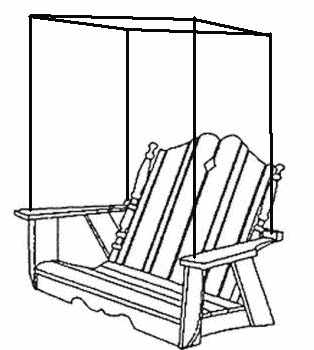Swinging Physics.
Pendulums are objects swinging periodically from a fixed support in a gravitational field. The simplest kind, appropriately called a "simple pendulum", is a negligibly small object, called the "bob" suspended by a string of negligible weight from a fixed point. It's period is given by T = 2π√(R/g) where R is the length of the suspension string and g is the acceleration due to gravity. This equation is a good approximation for practical purposes, for small angles of swing.The idealized swinging point mass is a bit unrealistic. Increase the size of the bob and you get a slightly different result. If the swinging object is of considerable size, or the angle of swing very large, the result can be very different.

One example of a non-simple pendulum is the very familiar porch swing, a chair, usually seating two people, suspended from the ceiling by four ropes. Let's consider the simplest type in which the four ropes are of equal length and all parallel, attached between the chair arms and the ceiling. By itself it has a natural period, T, swinging in the usual way, front to back, and the formula above applies, but only if you insert an appropriate value for the suspension length, R. Should this be
- the length of the supporting ropes?
- the distance from the ceiling support to the chair seat?
- the average of the above two distances?
- the sum of the rope lengths?
- greater than the unloaded swing.
- the same as the unloaded swing.
- less than the unloaded swing.
- greater than the unloaded swing.
- the same as the unloaded swing.
- less than the unloaded swing.
Answer.
The period of the swing is the same as that of a simple pendulum of length R, where R is the length of the supporting ropes. The parallel rope suspension allows the chair to swing without rotation. Therefore each and every little piece of the chair swings in an arc of the same radius. Imagine all of these pieces separated, swinging in synchronism. Each would have period T = 2π√(R/g) where R is the radius of the arc of motion of each piece. So the entire plate also has that period—the period of a simple pendulum. In fact, an object of any shape and mass suspended from three or four parallel ropes of equal length also has the same period. Any solid shape suspended from four parallel ropes of equal length does also.Such parallel suspension ensures that the object swings, but does not rotate. The period is the same for forward swinging or sidewise swinging, or even swinging in an oval path. This can be thought of as a superposition of left right and forward back motions of the same period. And the period is independent of the mass on the swing.
But if the suspension ropes are non-parallel, some interesting motion results. A flat plate, suspended that way from its four corners can swing with a rocking motion. Definitely not elementary, but quite relaxing. In fact this could easily lead us to suspensions causing gentle rocking as in the piece of furniture known as the platform rocking chair.
In this solution we have used the same argument that Galileo used to argue that the time it takes a body to fall a given distance is independent of the body's mass. He imagined dropping two identical bodies side by side, close to one another. Being identical, they take the same time to fall. Fasten them together and they still take the same time, though now the composite body has twice as much mass.

Another neat application of this principle is to prove something seldom proven in elementary physics textbooks. Why is the period of a simple pendulum (moving in a vertical plane) independent of its mass? Imagine two identical simple pendulums swinging side by side in synchronism. Of course their periods are the same since they are identical. Now bring them close together side by side, so the pendulum bobs are nearly touching. Both periods are still the same. Now glue the bobs together so they are, in effect, one pendulum. The period of this composite body is still the same, though it is twice the mass of either of the original pendulums. Therefore the period of a simple pendulum is independent of the mass.
The argument still requires that we show the generality of the result. Imagine splitting a pendulum bob into two equal parts. Each has the same period. Three equal parts, same period. N parts... These small bobs can be recombined in whatever ways are required to make pendulums of different masses all with the same period.
This works even if the pendulum bobs are large, so long as both bobs swing in exactly the same way, that is, along the same arc. And it even works if the angle of swing is large. If the individual pieces didn't swing in an arc of the same radius, gluing them together would result in a swing around some other arc, with a different period. This reminds us that the R in the formula for a simple pendulum is the radius of the arc the bob's motion, not simply the suspension length. A mass sliding on a frictionless track curved in a circular arc would have the same period. Textbooks somewhat mislead by using L in the formula for the period, implying the length of the supporting string. The pendulum with a string support is only a special case.
Return to Physics puzzles.
Return to the Donald Simanek's home page.